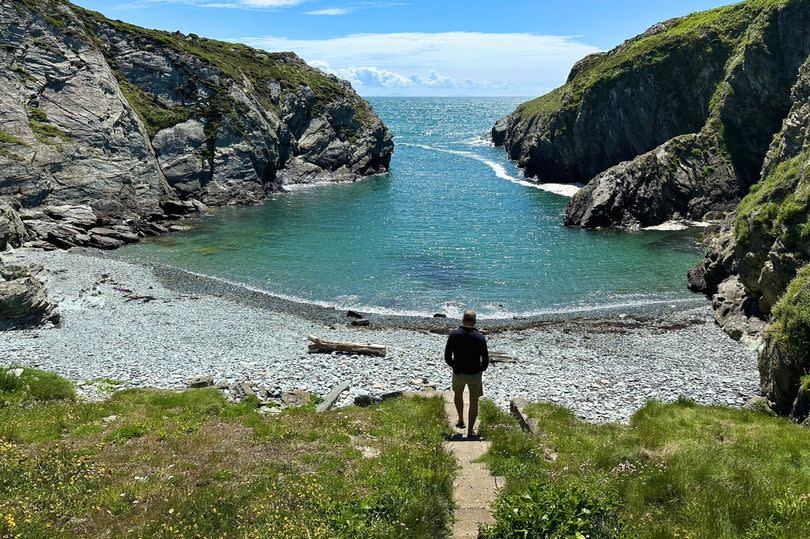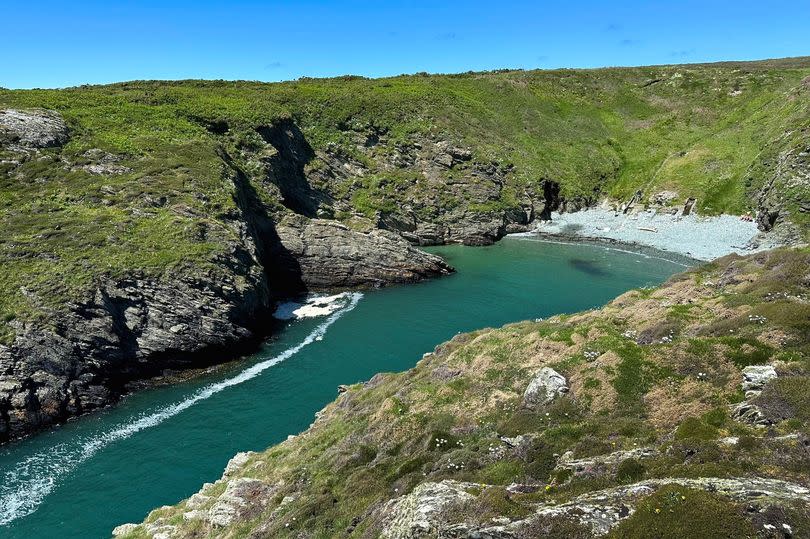Idyllic hidden cove best found by stumbling across it
A secluded coastal cove tucked away in a melee of finger inlets was once regarded as a secret haunt for locals on Anglesey’s Holy Island. It’s hidden away and is the kind of place that almost deserves to be reached by accident as a surprise find during a walk on the path that hugs the area’s dramatic coastline
Stone steps lead down steeply to a shingle beach where waves gently lap on still-wind days. Viewed from above the beach and its inviting waters can appear impossibly tempting but for the prospect of the climb back up.
Happily a seat has been provided at the top. Sadly it’s quite often occupied as the views are stunning. “One of my favourite places,” said a woman on social media. “I often sit along the headland there and watch the old seal fishing along the swell at certain tides. Pure therapy.”
READ MORE: Police probe after man dies on Bardsey Island
READ MORE: Climbers 'saddened' by Welsh quarry names row but point to 'important distinction'
Porth Ruffydd is perhaps not quite the secret it once was. Paddleboarders and kayakers like to visit and it’s a cooling-off spot for walkers and their dogs. On some days it can be busy but on others you may be lucky and find the place almost to yourself.
The cove lies on Penrhos Feliw Common, which is commonly known as The Range because it was once used as a military firing range. South Stack lighthouse and RSPB reserve are a little further north. Steepling rock stacks and tiny rocky islands lie off shore and nearby is a dramatic sea arch still bravely resisting the elements. On the same stretch of coast is the prehistoric hillfort of Dinas and the tiny sandy cove of Porth Rhwydau with its multi-hued “serpents cave”.
For a short while Porth Ruffydd hosted a lifeboat station. This treacherous stretch of coast, running up to North Stack, was notorious for the dangers it posed for shipping. Matters came to a head when, on December 17, 1889, the barque Tenby Castle ran aground on rocks at Penrhos Point.
The Volunteer Life Brigade headed to the scene three miles overland from Holyhead. The port’s lifeboat and another from Rhoscolyn were launched but both were some distance from the ailing vessel. The North Wales Live Whatsapp community for top stories and breaking news is live now - here’s how to sign up.

By the time the Holyhead lifeboat arrived the vessel had sunk. Ultimately three crew were rescued but 11 were lost. In the aftermath a lifeboat station was built at Porth Ruffydd. A 34ft 10-oared lifeboat, the Norbury, was unveiled in August 1891 and stationed at Porth Ruffydd, often crewed by men from Holyhead.
When a new steam-powered lifeboat arrived at Holyhead, capable of reaching Holy Island’s west coast much quicker than the old oared vessel, it was decided the Norbury – the only lifeboat to serve at Porth Ruffydd – was no longer needed. It was broken up.
The station closed in 1904 but the boathouse survived in stages until 1997. Local people fondly remembered how it was a handy place for a stop and where youngsters would host the occasional party. On social media a woman recalled: “My dad used to take me here for lunch from the sea when we had days out fishing on the boat. Never used to see anyone. Felt like a secret."

Traces of the old boathouse remain below the steps down to Porth Ruffydd. On Boxing Day afternoon in 1940 the building was the scene of a terrible tragedy that devastated an entire community.
Three 14-year-old boys from Holyhead were killed in an explosion after finding a discarded mortar bomb on The Range and taking it to the abandoned lifeboat house. One boy, aged 12, survived to explain what had happened.
Writing online Holyhead Maritime Museum said: “Evidence given by the surviving boy tells that one of the group struck the bomb on the building floor causing it to explode. One boy was killed instantly; the other two died at Stanley Hospital the next day. It left the close-knit community of Millbank in shock.”

The museum noted that it wasn’t until 2017 that the tragedy was formally recognised as a product of the Second World War. The Commonwealth War Graves Commission’s website now lists the three boys as “civilian war dead”.
Visit now and memories of the cove’s tragic past have ebbed away, remembered instead in Holyhead. However there is a slate plaque by the steps recalls the 14 rescue launches made by Norbury lifeboat from Porth Ruffydd. Get the best island stories from our Anglesey newsletter sent every Friday.

 Yahoo News
Yahoo News 
